ISBN 978-1-57421-384-3 eISBN 978-1-60765-133-8 COPY PERMISSION: The written instructions, photographs, designs, patterns, and projects in this publication are intended for the personal use of the reader and may be reproduced for that purpose only. Any other use, especially commercial use, is forbidden under law without the written permission of the copyright holder. Every effort has been made to ensure that all information in this book is accurate. However, due to differing conditions, tools and individual skills, neither the author nor publisher can be responsible for any injuries, losses and other damages which may result from the use of the information in this book. INFORMATION: All rights reserved. All images in this book have been reproduced with the knowledge and prior consent of the artists concerned and no responsibility is accepted by producer, publisher or printer for any infringement of copyright or otherwise, arising from the contents of this publication.
Every effort has been made to ensure that credits accurately comply with information supplied. WARNING: Due to the components used in this craft, children under 8 years of age should not have access to materials or supplies. Under rare circumstances components of products could cause serious or fatal injury. Neither Design Originals, Suzanne McNeill, the product manufacturer or the supplier is responsible. NOTE: The use of products and trademark names is for informational purposes only, with no intention of infringement upon those trademarks. 2013 by Fran Ortmeyer, Carol C.
Porter, and Design Originals, www.d-originals.com, an imprint of Fox Chapel Publishing, 800-457-9112, 1970 Broad Street, East Petersburg, PA 17520. eBook Version 1.0 Introduction Everyone has within them the seed of creativity. It finds a way to blossom in whatever medium you choose to work. Beading with the Clover Loom has opened a new world within which I can express emotions and colors that define what creativity is for me.
Fran My first recollection of beaded loom work was feeling the silkiness of my mothers evening bag and the smooth band of beads in a childhood bracelet made by a Native American artisan. Beading on a loom has provided me with many hours of fascinating designs and rewarding results.
Carol We trust this book will be for you the gateway to a world of creative endeavors! Acknowledgments To our publisher and editors, thank you for your patience and encouragement through the process. Not just one person puts together a book, and we would like to thank all those behind the scenes.
I would like to give a special thank you to Carol Porter, who gave direction and guidance throughout this process and graciously shared her knowledge and insight with me. To my husband, for changing his schedules to allow me time for this exciting project, and family members who were constantly supportive and encouraging. To those of you that will use this book to create your own beautiful projectsI wish I could see each and every creation!
Fran Thank you Jan Carr for nudging us in this direction, and
Judith McCabe and Peg Couch for cheerleading
this project. Always thanks to my David for your unending support during the time of this writing. A special thanks to TOHO Beads for contributing your beautiful beads, some illustrations, and great support. Carol Materials & Supplies Thread: We recommend nylon monofilament thread, better known as Nymo.
Size B works best, as many passes can be made through the seed beads with it, while still accommodating both the thread and needle. Nymo does not need any conditioning, as it is not prone to fraying or twisting. Weve also used Superlon thread, also known as S-lon, with great results. Both threads come on spools and cones in a wide variety of colors. Neutral colors, such as black, white, tan, and gray can be used for the warp threads. We recommend using weft threads in colors that coordinate with whatever bead color falls to the outside edges of the woven piece, as this will help hide the thread.
If desired, a permanent maker can always be used to color the outer threads to match the beads. Be cautious when using transparent beads, as the thread color may distort or enhance the original bead color. Needles: Generally, a long thin needle with a narrow eye works best for loom work. We use Clover Needlecraft Incorporateds Beading Needles numbers 1013. In addition, a simple needle threader is handy for ushering the thread through the needle eye, and a short needle is useful for hiding warp threads. Seed beads: Seed beads are a class of beads that are the smallest glass beadsnot all seed beads are created equal! Common sizes include 15/0, 11/0, 8/0, and 6/0.
Weve found that Japanese seed beads are the most uniform, making them the best for weaving. In addition, the depth of color range and finishes for these beads is most extensive. Uniform beads result in elegant and even loom work with a silky, smooth texture. Using different types of seed beads in one weaving will throw off the uniformity of the finished piece. The projects in this book use size 11/0 Toho seed beads exclusively. Scissors: Choose a small pair of scissors with a nice sharp tip. 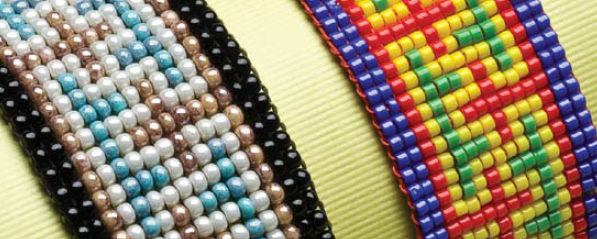 The bracelet on the right uses 11/0 Toho Treasure (cylinder) beads, while the bracelet on the left uses 11/0 Toho Round beads.
The bracelet on the right uses 11/0 Toho Treasure (cylinder) beads, while the bracelet on the left uses 11/0 Toho Round beads. 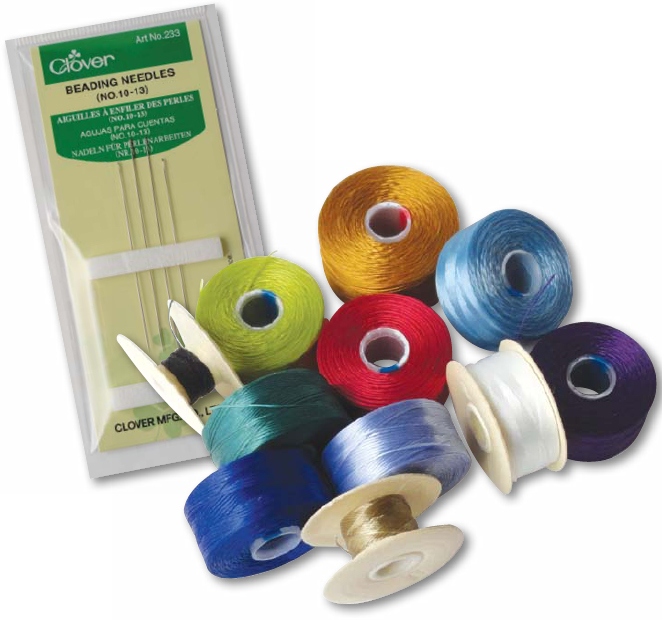
 Here, light silver round beads have been used in a design that also contains cylindrical beads.
Here, light silver round beads have been used in a design that also contains cylindrical beads. 
 Here, light silver round beads have been used in a design that also contains cylindrical beads.
Here, light silver round beads have been used in a design that also contains cylindrical beads.
As a result of using two different types of beads, the rows are becoming uneven. 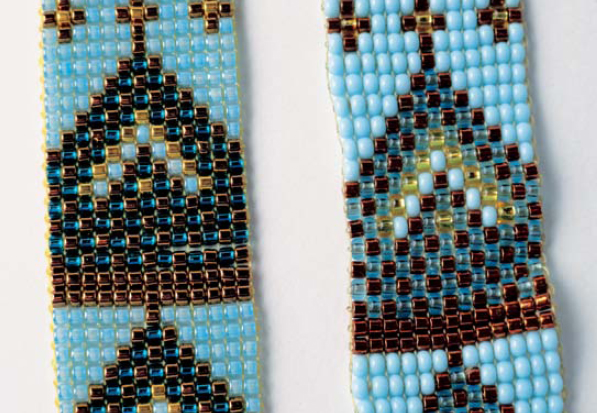 The outer edges of the right bracelet are uneven, due to mixing round and cylindrical beads. The left bracelet uses beads of the same type, resulting in a uniform, professional look. The Loom Basics Part Names and Functions
The outer edges of the right bracelet are uneven, due to mixing round and cylindrical beads. The left bracelet uses beads of the same type, resulting in a uniform, professional look. The Loom Basics Part Names and Functions 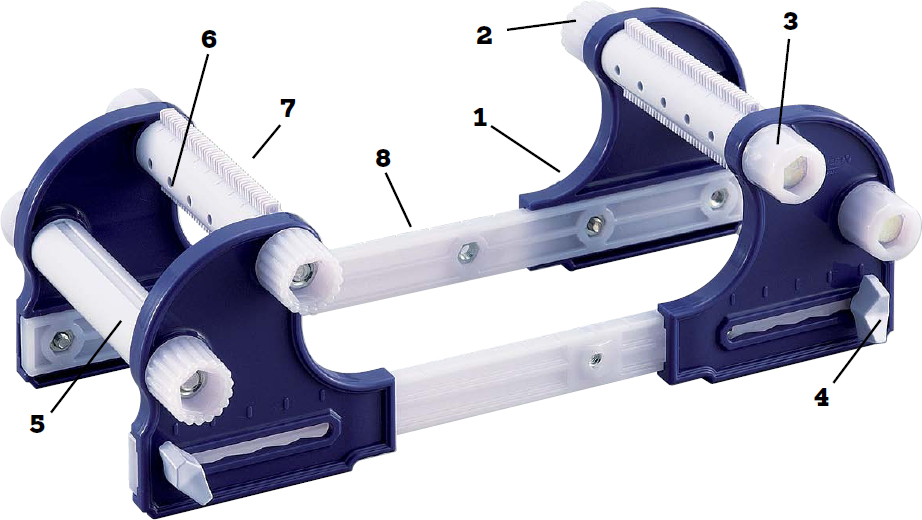
- Frame
- Release knobs A (loosen or tighten the beams)
- Release knobs B (rotate the beams)
- Adjustment screws (allow adjustment of rail length between warp guide beams)
- Winding beams (keep ends of warp threads in place and wind long pieces)
- Peg holes (for use with the Continuous Warp Method, see page 6)
- Warp guide beams (beams with grooves to guide the warp threads)
- Rails
Grooves The warp guide beams contain two different types of grooves:
Grooves (a): Use for cylinder beads (size 11/0). The maximum width of your woven piece will be about 29
/16 (6.5cm) wide, or 43 beads across (44 warp threads).
Grooves (b): Use for round beads (size 11/0).
The maximum width of your woven piece will be about 21/2 (6.5cm) wide, or 39 beads across (40 warp threads). Grooves (b) can be identified by the horizontal line running along the base of the grooves. 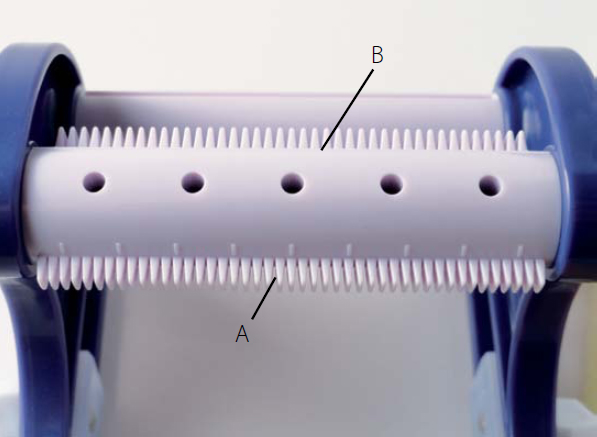
Next page

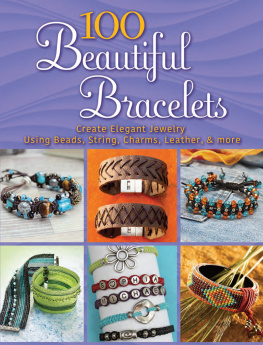
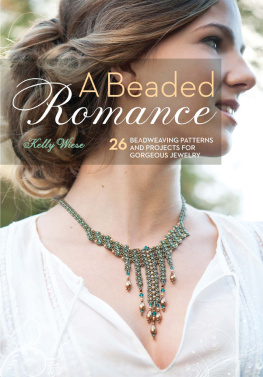
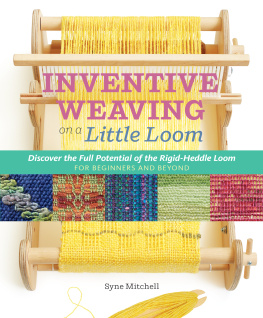
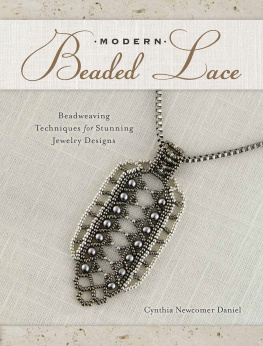

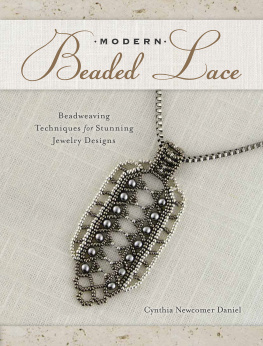
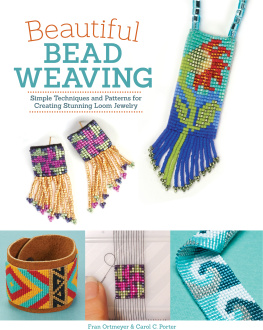
 The bracelet on the right uses 11/0 Toho Treasure (cylinder) beads, while the bracelet on the left uses 11/0 Toho Round beads.
The bracelet on the right uses 11/0 Toho Treasure (cylinder) beads, while the bracelet on the left uses 11/0 Toho Round beads. 
 Here, light silver round beads have been used in a design that also contains cylindrical beads.
Here, light silver round beads have been used in a design that also contains cylindrical beads.  The outer edges of the right bracelet are uneven, due to mixing round and cylindrical beads. The left bracelet uses beads of the same type, resulting in a uniform, professional look. The Loom Basics Part Names and Functions
The outer edges of the right bracelet are uneven, due to mixing round and cylindrical beads. The left bracelet uses beads of the same type, resulting in a uniform, professional look. The Loom Basics Part Names and Functions 
